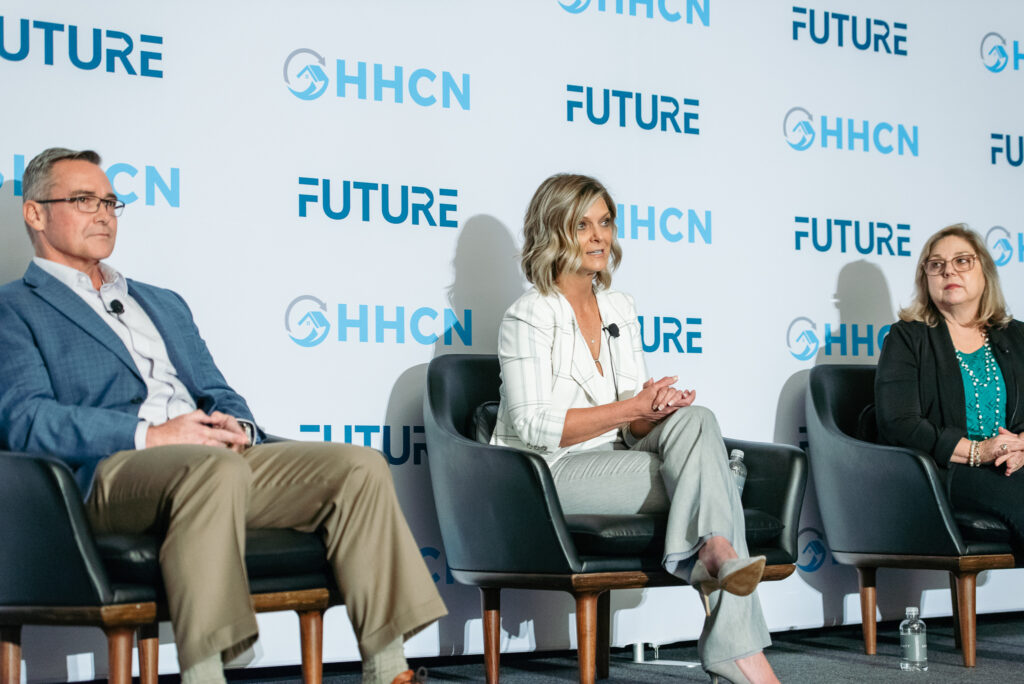
This article is a part of your HHCN+ Membership
Top home health leaders maintain that they’re operating in a space filled with “tons of opportunity.”
Payment uncertainty and other contemporary operating dynamics can muddy the waters, but there’s a way through those challenges, those leaders believe.
“I’m going to sound delusional,” Pinnacle Home Care CEO Shane Donaldson told me on stage last week at Home Health Care News’ FUTURE conference. “But I think [the home health industry] is in a great place for the future.”
At the conference, many of the same talking points were hit: Medicare Advantage (MA), fee-for-service rate cuts and staffing.
But providers are on the brink of their third straight year of rate cuts, and are about a decade into significant MA penetration in most cases. The staffing situation ebbs and flows, and providers are used to that, too.
As I talked to home health leaders in one-on-ones and on stage last week, I filled a whole page of notes related to what providers were bullish on.
Donaldson is bullish on the entire industry. Other leaders, too, are bullish – and offered specifics on where they feel like they can score some ‘wins’ in the near-term future to keep their patients happy and their margins healthy.
Those notes, quotes and other takeaways from last week’s FUTURE conference in Nashville, Tennessee, are the topic of this week’s exclusive, members-only HHCN+ Update.
Tons of opportunity
Pinnacle Home Care is one of the largest home health providers in the state of Florida. The New York-based HCS-Girling recently acquired Pinnacle, as both companies look to accelerate their growth goals.
At some point, Donaldson said that he believes HCS-Girling – along with Pinnacle – will have a home-based care footprint all along the East Coast.
Donaldson believes that home health providers will have the ability to optimize operations so much over the next few years that CMS will have to again consider large cuts to payment. He said it would be a “good problem to have.”
“I have a belief that in the not-too-distant future, if we take advantage of the current technologies, when we submit our cost reports, the problem we will have is that our margins are too high,” Donaldson said. “With artificial intelligence, robotic process automation, predictive analytics – all of these things that we have at our fingertips now are going to make life so much easier.”
Donaldson was essentially suggesting that margins will improve so much because of newly available technology that the Centers for Medicare & Medicaid Services (CMS) will again feel the need to chop rates.
Even if that sounds “delusional” – as Donaldson warned it would – many providers feel the same about certain technology advancements.
Take the aforementioned issues plaguing home health care. Scheduling is the leading cause of turnover in the industry, and there’s now AI solutions to address that. That improves retention, and, in turn, staffing. The same goes for AI that helps reduce clinicians’ documentation time.
Predictive analytics can help better manage patients with chronic conditions, which will help in the Home Health Value-Based Purchasing (HHVBP) and in value-based arrangements with other payers.
Those are just a few examples. And, of course, it won’t just be that easy.
But nearly every vendor was enthusiastic about these new offerings at the conference. This time, their enthusiasm was matched by providers.
By driving down operating costs, providers will also be better able to take on MA members that come with a lower – or currently non-existent – margin. Compassus CEO Mike Asselta suggested on stage that providers needed to go through some “maturation” before realizing all of the opportunity that lies ahead of them.
That mostly had to do with presenting value to payers, however.
In that arena, providers are already figuring out ways to better deal with payers, even if a better way is walking away from agreements entirely.
“I would suggest that providers really look at their [payer] strategy,” Interim HealthCare COO Rexanne Domico also said on stage. “What are the regional opportunities? What are other national opportunities? Where can you find that upside that’s not necessarily wholly dependent upon the big managed care providers? There’s some opportunity that’s still out there.”
Almost every provider still agrees that working with health plans in home health care is not easy.
But, anecdotally, providers told me that they’ve had a much better go at it when working with regionally focused plans.
“Some of our best partners are those regional partners,” Well Care Health COO Rebecca Higbee said on stage. “Those local partners where you can speak to the actual decision makers of the plan.”
Oftentimes, within national health plans, the decision makers on home health rates are siloed from the head decision makers. The rate setters are most interested in keeping costs down, while the head decision makers may see more home health access as a better long-term strategy.
That disconnect leads to snags in negotiations between national MA plans and home health providers.
“It’s really difficult when you’re speaking with large payers,” Higbee continued. “You’re not going to change their mind about the directives that they’ve been given. You’re not going to change their mind about the plan that they have laid out for the next quarter. But you can speak to the medical director of a local plan and really get their buy-in, in terms of the quality and the return for them.”
Domico also said that she believes there’s room for providers to get “more creative” in how they approach different payers, specifically around the presentation of home health care’s value.
A slew of leaders told me that they were encouraged by Enhabit’s (NYSE: EHAB) termination of its contract with UnitedHealthcare earlier this month.
Providers want to work with big payers, but they also need better rates – at least for now.
“I would just say that my heart was warm the other day when Enhabit walked away from the table with UHC,” Donaldson said. “I think that we’ll look back on that as being a significant event.”
Companies featured in this article:
Compassus, Interim Healthcare, Pinnacle Home Care, Well Care Health




